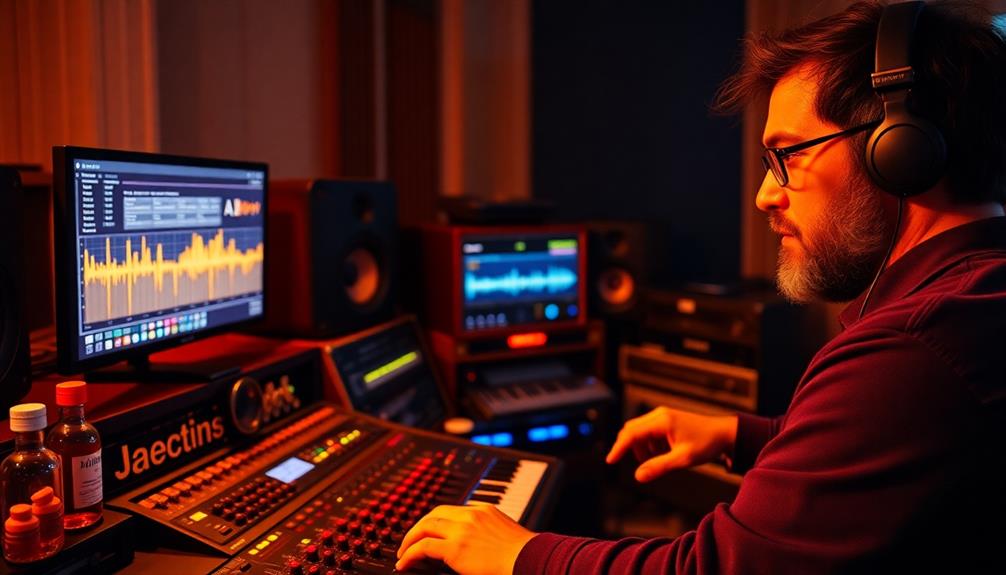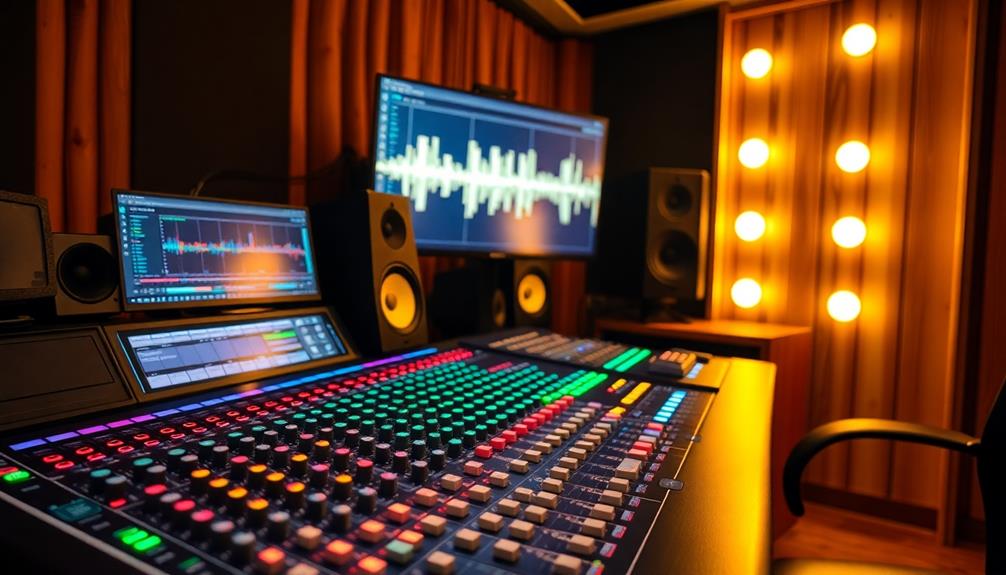Using saturation can greatly enhance your tracks by adding warmth and character. When you apply it, you're introducing harmonic distortion, which enriches the sound. Choose from various types like tape for vintage warmth, tube for smooth vocals, or transistor for punchy drums. Start with subtle levels, gradually increasing intensity to prevent overwhelming your mix. Consider using parallel processing to blend saturated signals with clean ones while keeping clarity intact. Each technique helps you achieve that desired sound. If you want to explore advanced methods and specific applications, there's a wealth of insights waiting for you to discover.
Key Takeaways
- Saturation enhances audio by introducing harmonic distortion, adding warmth and character to tracks through subtle applications on individual instruments.
- Different types of saturation, like tape and tube, provide unique textures that enrich sound quality and evoke emotional depth.
- Utilize parallel processing to blend saturated signals with clean tracks, preserving clarity while enhancing depth and character in the mix.
- Gradually increase saturation intensity to achieve optimal warmth without overwhelming the overall mix, ensuring balanced clarity across all elements.
- Target specific instruments, such as using tube saturation for vocals and tape saturation for drums, to achieve desired tonal qualities and enhance clarity.
Understanding Saturation

When you immerse yourself in music production, understanding saturation is vital for achieving that rich, full sound you're after. Saturation occurs when audio signals exceed maximum headroom, resulting in harmonic distortion that enhances warmth and character in your tracks. This process introduces compression and adds harmonic content, transforming cold, digital sounds into more organic audio.
You'll often encounter two main types of saturation: analog and digital. Analog saturation, often achieved through hardware like tape machines or tube preamps, imparts a unique warmth that some find irreplaceable. On the other hand, digital saturation using plugins offers greater control and flexibility within your DAW, allowing you to experiment with various settings without the constraints of physical equipment.
Understanding the nuances of saturation is essential. The role of even and odd harmonics can greatly affect your mixing. Even harmonics tend to add warmth, while odd harmonics introduce a bit of edge or distortion.
Whether you're applying tape saturation for a vintage vibe or tube saturation for smoothness, each type brings its own character to your audio, enhancing the overall texture of your music.
Types of Saturation

Saturation techniques can vary considerably, and each type offers unique qualities that can enhance your music.
Tape saturation mimics the warmth of magnetic tape recording, adding both even and odd harmonics to your audio signal. It creates a smooth character while subtly compressing the sound, making it a favorite for achieving a vintage feel.
Tube saturation, on the other hand, emulates the rich tones of vacuum tube amplifiers, producing warm distortion primarily made up of even-order harmonics. It's perfect for vocals and instruments when you want that lush sound.
In contrast, transistor saturation introduces odd-order harmonics, resulting in a punchy, aggressive tone often favored in rock and electronic music, enhancing clarity without harshness.
You might also consider overdrive, which offers a milder form of saturation. It adds warmth and grit, commonly used with electric guitars and vocals to create a pleasing harmonic distortion that enhances presence.
Finally, fuzz provides an extreme type of saturation, transforming audio signals into thick, heavily distorted sounds, perfect for rock and psychedelic genres.
Techniques for Application

When applying saturation, start with subtle amounts on individual tracks to enhance warmth without overpowering the original sound.
You can also target specific instruments by using techniques like parallel processing to maintain clarity while adding character.
Experimenting with these strategies will help you achieve a polished mix that retains its integrity.
Subtle Application Strategies
To achieve a warm and inviting sound in your mix, start with subtle saturation settings on individual tracks. Gradually increase the intensity to enhance warmth without overwhelming the original sound character.
For your drums sound, consider utilizing tape saturation. This technique smooths transients and adds punchiness while keeping the gain low to avoid undesirable distortion.
When working with vocals, apply tube saturation to enrich the mid frequencies, promoting a fuller and more natural presence in the mix. Experiment with parallel processing by blending a saturated duplicate track with the original. This allows you to add warmth while retaining clarity and dynamics, ensuring your mix remains vibrant.
Implementing multiband saturation techniques is another effective strategy. By targeting specific frequency ranges, you can enhance warmth in the low-end while maintaining clarity in higher frequencies.
This compressive enhancement allows for a balanced mix, ensuring that each element shines through without muddying the overall sound. With these subtle application strategies, you'll find the right balance of saturation that enriches your tracks, creating a warm and inviting listening experience.
Targeted Instrument Enhancement
Building on subtle application strategies, targeted instrument enhancement allows you to apply saturation techniques that cater to the unique characteristics of each track.
For vocals, using tube saturation adds warmth and richness, helping them sit nicely in the mix while introducing harmonic complexity without overwhelming their original tone.
On drums, especially the snare and kick, tape saturation delivers a punchy sound that glues elements together and smooths out transients.
When working with bass tracks, focus on upper harmonics by applying saturation to create definition and clarity, ensuring the low-end translates well on smaller speakers.
For guitars, analog-style saturation enhances natural overtones, adding depth and character that enriches the overall mix without sounding harsh.
These targeted enhancements not only elevate individual tracks but also contribute to the cohesiveness of your entire production.
Remember, the key to effective saturation is moderation; too much can muddy your mix.
Parallel Processing Techniques
Although parallel processing might seem complex at first, it offers a powerful way to enhance your tracks with saturation while preserving their clarity. By duplicating a track and applying saturation effects to the duplicate, you can blend the saturated and clean signals, adding depth, warmth, and character without overwhelming the mix.
Here are some key benefits to evaluate:
- Enhanced punch on drum buses, giving your beats a compelling energy.
- Diverse tonal qualities when experimenting with tape or tube saturation plugins.
- Creative freedom to adjust the mix knob, balancing original and processed sounds.
- Cohesion in tracks, ensuring all elements work together harmoniously.
- Preservation of dynamics, allowing the original performance to shine through.
Using parallel processing for saturated elements empowers you to achieve a rich, polished sound while maintaining the integrity of your original audio.
Don't hesitate to experiment with different saturation types to discover what best complements your mix. With this technique, you'll find it easier to craft tracks that resonate with warmth and character, providing an engaging listening experience.
Real-World Applications

When you're working on a specific genre, knowing how to apply saturation can really make a difference in your mix.
For instance, using it on drum tracks can enhance punchiness in rock and hip-hop, while adding warmth to vocals guarantees they sit well in the overall sound.
You'll find that different instruments like bass and guitars also benefit from saturation, each adding unique texture and character to your production.
Genre-Specific Saturation Techniques
Saturation techniques vary widely across different music genres, each offering unique benefits that enhance the final mix. Understanding genre-specific saturation techniques can help you achieve the desired sound for your tracks.
- Electronic music: Use aggressive saturation on synths and drums to boost energy levels and drive.
- Rock music: Apply tube saturation to guitars and vocals, adding grit and character, enhancing overall presence.
- Jazz recordings: Embrace subtle tape saturation to create warmth and smoothness, contributing to a more cohesive sound.
- Pop music: Implement controlled saturation on vocals to enhance clarity and add richness, ensuring they stand out without overwhelming other elements.
- Film scoring: Utilize saturation to evoke emotional depth, enhancing soundscapes for a more immersive experience.
Instrument-Specific Applications
In music production, applying saturation to specific instruments can greatly enhance their presence and character in a mix. Here's how you can use saturation effectively for various instruments:
| Instrument | Saturation Type | Effect |
|---|---|---|
| Drums | Tape Saturation | Boosts punchiness and adds warmth |
| Vocals | Tube Saturation | Enhances warmth and emotional impact |
| Guitars | Analog-style Saturation | Enriches natural overtones, adds character |
| Bass | Harmonic Saturation | Increases clarity on small speakers |
| Synths | Transistor Saturation | Creates a punchy, aggressive tone |
For drums, adding tape saturation to your snare and kick can make them pop without harshness. When it comes to vocals, tube saturation introduces rich harmonics that improve clarity and warmth. For bass, focusing on upper harmonics through saturation helps maintain definition, especially on smaller speakers. Electric guitars benefit from analog-style saturation, which brings warmth and character to both rhythm and lead parts. Ultimately, transistor saturation can give your synths an energetic drive, perfect for electronic and rock genres.
Common Pitfalls

Balancing clarity and warmth is an essential challenge in music production, especially when applying saturation. One common pitfall is over-saturation, which often leads to muddiness in your mixes. To keep your sound sharp, you need to apply saturation subtly. Here are some pitfalls to watch for:
- Excessive distortion that overwhelms rather than enriches.
- Digital artifacts creeping in from aggressive saturation settings.
- Muddiness that clouds the mix, hiding important details.
- Loss of integrity in the original sound as effects pile up.
- Neglecting monitoring saturation, leading to unintended results.
Using high-quality plugins can help emulate that sought-after analog warmth while minimizing unwanted artifacts.
Always remember to check your saturation levels in real-time, ensuring they complement other effects like EQ and compression. This way, you maintain the clarity of your tracks while enhancing their richness.
Be mindful to preserve the clean sound quality, as excessive distortion can detract from the character you aim to create.
Advanced Techniques

Mastering the art of saturation can greatly elevate your music production, providing depth and character to your tracks. One advanced technique is multiband saturation, which allows you to apply saturation selectively across different frequency ranges. This way, you can add warmth and character to specific instruments without altering the entire mix.
For instance, incorporating techniques from songs like Blue Skies and Lemonade can inspire a joyful and nostalgic sound that enhances your overall production.
Another effective method is parallel processing. By blending saturated signals with clean tracks, you enhance warmth while preserving the original clarity and dynamic range of your sound.
Don't forget to experiment with different saturation types, such as tape for warmth, tube for richness, and transistor for punch. Each brings unique tonal colors to your music, enriching the overall texture.
Utilizing targeted application of saturation lets you focus on specific instruments. For example, applying tube saturation to vocals can enhance smoothness, while tape saturation on drums can deliver punch.
When you experiment with saturation levels, start with subtle amounts and gradually increase. This helps you find that sweet spot where warmth and character shine through without overwhelming the original sound.
Embrace these techniques to create engaging and polished tracks that resonate with listeners.
Frequently Asked Questions
What Does Saturation Do to a Track?
Saturation enriches your track by adding harmonic distortion, enhancing its tonal quality. It compresses audio, balances dynamics, and increases perceived loudness, resulting in a fuller sound that feels vibrant and engaging in your mix.
When to Use Saturation?
You should use saturation during tracking, mixing, and mastering. It enhances recordings, adds depth, and polishes the final mix. Just remember to apply it subtly to avoid muddiness and maintain clarity in your sound.
What Are the Different Types of Saturation in Mixing?
Think of saturation as seasoning for your mix. You've got tape for warmth, tube for smoothness, transistor for punch, overdrive for grit, and fuzz for that bold, edgy flavor. Each type enhances your sound uniquely.
What Is the Difference Between an Exciter and a Saturation?
An exciter enhances clarity and brightness in your audio, targeting high frequencies, while saturation enriches your sound with warmth and fullness across a broader spectrum. Each serves a unique purpose in your mixing process.
Conclusion
Incorporating saturation into your tracks can be like adding a splash of color to a black-and-white photo—it brings warmth and character that makes your music come alive. By understanding the types of saturation and mastering the techniques for application, you'll breathe new life into your sound. Just remember to avoid common pitfalls and explore advanced methods to truly elevate your mixes. Embrace saturation, and watch your tracks transform into something truly special.










